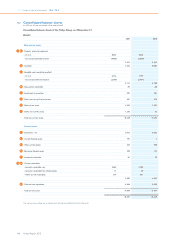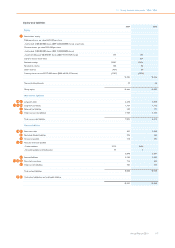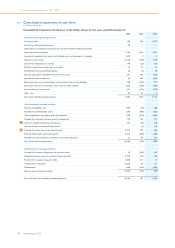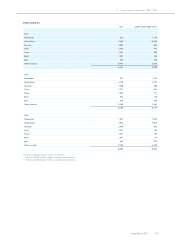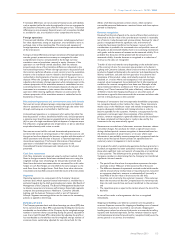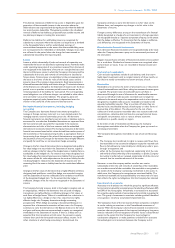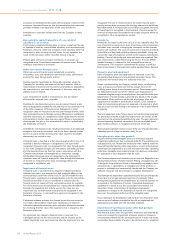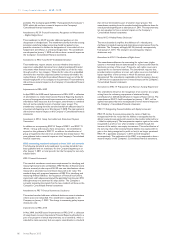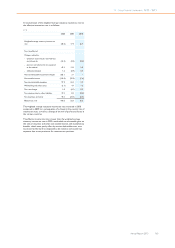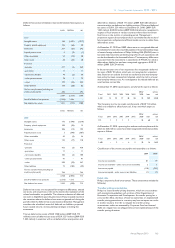Philips 2010 Annual Report Download - page 156
Download and view the complete annual report
Please find page 156 of the 2010 Philips annual report below. You can navigate through the pages in the report by either clicking on the pages listed below, or by using the keyword search tool below to find specific information within the annual report.
13 Group financial statements 13.10 - 13.10
156 Annual Report 2010
A provision for product warranty is made at the time of revenue
recognition and reflects the estimated costs of replacement and free-
of-charge services that will be incurred by the Company with respect to
the products. For certain products, the customer has the option to
purchase an extension of the warranty, which is subsequently billed to
the customer. Revenue recognition occurs on a straight-line basis over
the contract period.
Revenue from services is recognized when the Company can reliably
measure the amount of revenue and the associated cost related to the
stage of completion of a contract or transaction, and the recovery of
the consideration is considered probable.
Royalty income, which is generally earned based upon a percentage of
sales or a fixed amount per product sold, is recognized on an accrual
basis.
Grants from the government are recognized at their fair value where
there is a reasonable assurance that the grant will be received and the
Company will comply with all attached conditions. Government grants
relating to costs are deferred and recognized in the Statements of
income over the period necessary to match them with the costs that
they are intended to compensate.
Employee benefit accounting
A defined contribution plan is a post-employment benefit plan under
which an entity pays fixed contributions into a separate entity and will
have no legal or constructive obligation to pay further amounts.
Obligations for contributions to defined contributions pension plans
are recognized as an employee benefit expense in the Statement of
income in the periods during which services are rendered by
employees.
A defined benefit plan is a post-employment benefit plan other than a
defined contribution plan. The net pension asset or liability recognized
in the Consolidated balance sheet in respect of defined-benefit
postemployment plans is the fair value of plan assets less the present
value of the projected defined-benefit obligation at the balance sheet
date, together with adjustments for projected unrecognized past-
service costs. The projected defined-benefit obligation is calculated
annually by qualified actuaries using the projected unit credit method.
Recognized assets are limited to the present value of any reductions in
future contributions or any future refunds.
To the extent that post-employment benefits vest immediately
following the introduction of a change to a defined-benefit plan, the
resulting past service costs are recognized immediately.
For the Company’s major plans, a full discount rate curve of high-quality
corporate bonds (Bloomberg AA Composite) is used to determine the
defined-benefit obligation, whereas for the other plans a single-point
discount rate is used based on the plan’s maturity. Plans in countries
without a deep corporate bond market use a discount rate based on the
local sovereign curve and the plan’s maturity.
Pension costs in respect of defined-benefit postemployment plans
primarily represent the increase of the actuarial present value of the
obligation for postemployment benefits based on employee service
during the year and the interest on this obligation in respect of
employee service in previous years, net of the expected return on plan
assets.
Actuarial gains and losses arise mainly from changes in actuarial
assumptions and differences between actuarial assumptions and what
has actually occurred. The Company recognizes all actuarial gains and
losses directly in equity through the Consolidated statements of
comprehensive income.
The Company recognizes gains and losses on the curtailment or
settlement of a defined benefit plan when the curtailment or settlement
occurs. The gain or loss on curtailment comprises any resulting change
in the fair value of plan assets, change in the present value of defined
benefit obligation and any related actuarial gains and losses and past
service cost that had not previously been recognized.
In certain countries, the Company also provides post-retirement
benefits other than pensions. The costs relating to such plans consist
primarily of the present value of the benefits attributed on an equal basis
to each year of service and interest cost on the accumulated
postretirement benefit obligation, which is a discounted amount.
The Company recognizes a liability and an expense for bonuses and
profit-sharing, based on a formula that takes into consideration the
profit attributable to the Company’s shareholders after certain
adjustments. The Company recognizes a provision where contractually
obliged or where there is a past practice that has created a constructive
obligation.
Share-based payment
The Company recognizes the estimated fair value, measured as of grant
date of equity instruments granted to employees as personnel expense
over the vesting period on a straight-line basis, taking into account
expected forfeitures. The Company uses the Black-Scholes option-
pricing model to determine the fair value of equity instruments.
The fair value of the amount payable to employees in respect of share
appreciation rights, which are settled in cash, is recognized as an
expense, with a corresponding increase in liabilities, over the vesting
period. The liability is remeasured at each reporting date and at
settlement date. Any changes in fair value of the liability are recognized
as personnel expense in the Statement of income.
Financial income and expenses
Financial income comprises interest income on funds invested
(including available-for-sale financial assets), dividend income, net gains
on the disposal of available-for-sale financial assets, net fair value gains
on financial assets at fair value through profit or loss, net gains on the
remeasurement to fair value of any pre-existing interest in an acquiree,
and net gains on hedging instruments that are recognized in the
Statement of income. Interest income is recognized on accrual basis in
the Statement of income, using the effective interest method. Dividend
income is recognized in the Statement of income on the date that the
Company’s right to receive payment is established, which in the case of
quoted securities is normally the ex-dividend date.
Financial expense comprise interest expense on borrowings, unwinding
of the discount on provisions and contingent consideration, losses on
disposal of available-for-sale financial assets, net fair value losses on
financial assets at fair value through profit or loss, impairment losses
recognized on financial assets (other than trade receivables), and net
losses on hedging instruments that are recognized in the Statement of
income.
Borrowing costs that are not directly attributable to the acquisition,
construction or production of a qualifying asset are recognized in the
Statement of income using the effective interest method.
Foreign currency gains and losses are reported on a net basis as either
financial income or financial cost depending on whether foreign
currency movements are in a net gain or net loss position.
Income tax
Income tax comprises current and deferred tax. Income tax is
recognized in the Statement of income except to the extent that it
relates to a business combination, or items recognized directly within
equity or in other comprehensive income. Current tax is the expected
tax payable on the taxable income for the year, using tax rates enacted
or substantially enacted at the reporting date, and any adjustment to tax
payable in respect of previous years.
Deferred tax assets and liabilities are recognized, using the balance
sheet method, for the expected tax consequences of temporary
differences between the carrying amounts of assets and liabilities and
the amounts used for taxation purposes. Deferred tax is not recognized
for the following temporary differences: the initial recognition of
goodwill, the initial recognition of assets and liabilities in a transaction
that is not a business combination and that affects neither accounting
nor taxable profit, and differences relating to investments in subsidiaries
to the extent that they probably will not reverse in the foreseeable
future. Deferred tax is measured at the tax rates that are expected to
be applied to temporary differences when they reverse, based on the
laws that been enacted or substantively enacted by the reporting date.
Deferred tax assets and liabilities are offset if there is a legally
enforceable right to offset current tax liabilities and assets, and they
relate to income taxes levied by the same tax authority on the same
taxable entity, or on different tax entities, but they intend to settle
current tax liabilities and assets on a net bases or their tax assets and
liabilities will be realized simultaneously.
A deferred tax asset is recognized for unused tax losses, tax credits and
deductible temporary differences, to the extent that it is probable that
future taxable profits will be available against which they can be utilized.


